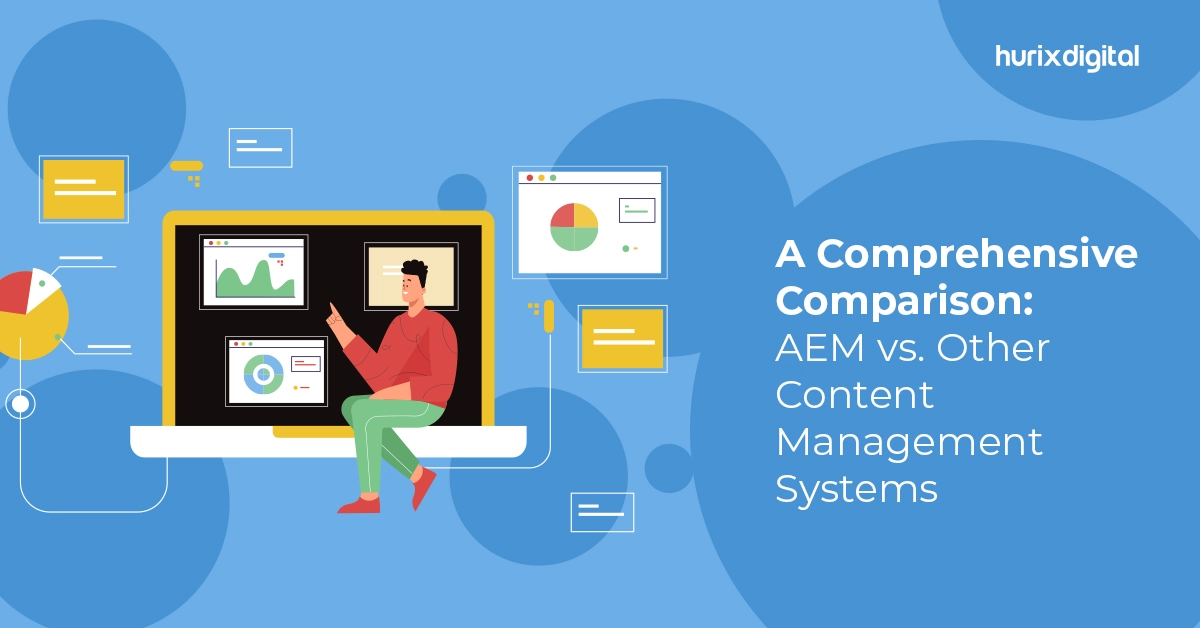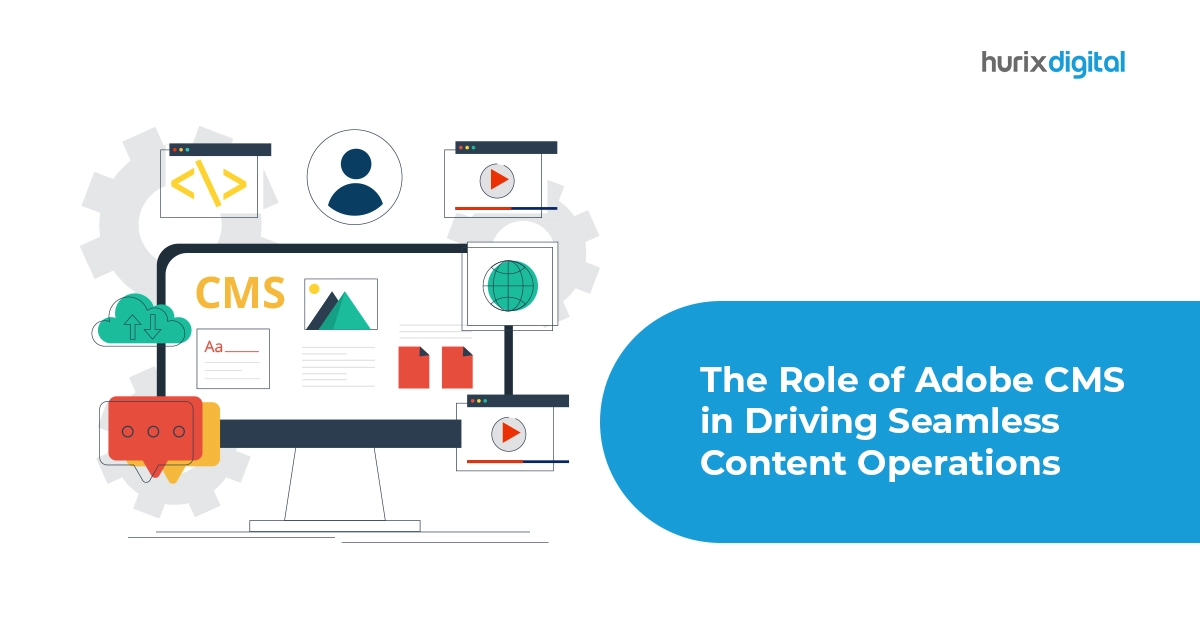
A Comprehensive Comparison: AEM vs. Other Content Management Systems
Summary
Compare Adobe Experience Manager (AEM) with other content management systems. This blog provides a detailed analysis to help you choose the right CMS for your needs.
Choosing the right CMS is similar to finding the perfect set of tools for your marketing strategy, allowing you to effortlessly and effectively engage with your customers. Your CMS can act as a powerful online sales assistant, emphasizing the importance of choosing a solution that meets your needs.
Nowadays, customers who are well-versed in technology contact you using different platforms. However, you must ensure that the fundamental message of interaction remains genuine and uniform, regardless of the communication channel utilized.
Your website serves as the essence of your company. Utilizing a dependable CMS enables you to efficiently handle content for display on various platforms, outshine your rivals, and establish a superior customer experience. The global CMS industry is expected to reach $123.5 billion by 2026, which makes it a wise investment for your business expansion.
In this blog, you will explore the factors why Adobe Experience Manager (AEM) is the preferred CMS choice for several business owners around the globe. With over 87% of Fortune 100 companies utilizing Adobe Experience Cloud solutions such as AEM, the industry’s widespread adoption and trust in Adobe’s solutions becomes evident.
However, before diving into the technicalities, you must have an overview of Adobe Experience Manager (AEM) and various Adobe AEM forms.
Table of Contents:
- Adobe Experience Manager (AEM) and its Components
- Seamless Integration: Adobe Experience Manager and Adobe Commerce
- 6 Reasons Why AEM is Better than Other Content Management Systems
- Final Words
Adobe Experience Manager (AEM) and its Components
AEM functions as a powerful CMS that enables smooth and dynamic management of digital assets. It provides extensive document management solutions, diverse engagement choices, community portals, and efficient tools for handling user-generated content.
Adobe Experience Manager (AEM) consists of five crucial components that establish the basis for its operations:
- Sites
- Assets
- Mobile
- Forms
- Community
These components together empower you to develop and distribute high-traffic websites, forms, and mobile applications.
AEM serves as a central hub for creative teams, promoting seamless collaboration between members across locations. It simplifies the process of delivering high-quality content effectively across multiple channels.
Being an integral component of Adobe AEM cloud, AEM offers various solutions like:
- Adobe Analytics
- Adobe Audience Manager
- Adobe Campaign
- Adobe Target
- Adobe Commerce Cloud
- Adobe Advertising
- Marketo Engage
Furthermore, AEM seamlessly integrates with Adobe Commerce to offer businesses a unified solution for content management and eCommerce.
Also Read: Maximizing ROI with AEM Consulting: Strategies for Effective Implementation
Seamless Integration: Adobe Experience Manager and Adobe Commerce
When used with Adobe Commerce Cloud, the seamless integration and compatibility between AEM and Adobe Commerce are evident, enhancing the user experience and showcasing their effectiveness in collaboration.
Ever since Adobe acquired Magento, it has emphasized integrating its content management system (AEM) and the eCommerce division (Adobe Commerce) to deliver a streamlined experience. This integration is extremely beneficial as it lets you manage their content and conduct their online business operations.
With Adobe Commerce, eCommerce brands can effectively utilize the platform for back-end operations while simultaneously leveraging AEM for front-end operations in a headless commerce model. This strategic combination of AEM and Adobe Commerce enables eCommerce brands to access superior commerce, content, and marketing features.
6 Reasons Why AEM is Better than Other Content Management Systems
AEM possesses several remarkable attributes that distinguish it from its competitors. Here are a few standout qualities that truly set it apart in the market:
1. Digital Asset Management (DAM)
The cloud-based Adobe AEM CMS offers a convenient and efficient solution for storing and organizing visual assets through its integrated Digital Asset Management (DAM) platform.
Being an AEM developer, you and your team members can leverage this centralized storage system facility to conveniently access project files from multiple locations and improve productivity. Additionally, the DAM offers several other notable features, including the seamless ability to drag and drop assets.
Unlike other CMS, AEM simplifies asset management, allowing easy access and boosting productivity. While some CMS may offer basic DAM capabilities, AEM’s advanced features, such as automatic web rendition generation and comprehensive asset information, set it apart.
2. Integration of Adobe Marketing Cloud
Marketing involves more than simply improving the web customer experience; it should also offer the ability to monitor analytics, target a particular audience, and brainstorm campaigns.
Adobe firmly believes that integrating the Adobe Marketing Cloud is a highly efficient method of linking any organization’s DAM with its marketing plans. While other CMS may lack this seamless connection, AEM offers unparalleled efficiency in analytics monitoring, audience targeting, and campaign management. This integration ensures consistency in branding and marketing strategies, a feature not commonly found in other CMS.
3. Streamlined Media Organization
AEM enables you to attach metadata and tags to files uploaded in the cloud, facilitating quick access to the media. This simplifies searches, saving time and enhancing efficiency. While some CMS may offer basic media organization features, AEM’s robust capabilities ensure quick and easy access to files, enhancing content management workflows.
Content editing within AEM allows you to efficiently create and oversee web pages within minutes instead of hours. The preview feature provides editors with a precise visualization of the content’s appearance without having to publish it.
4. Centralized Dashboard
The project dashboard’s centralized platform allows editors to manage and monitor projects effectively.
Each project is comprised of interconnected resources, which are displayed in a tile format for easy visualization. While some CMS may offer dashboard features, AEM’s centralized platform stands out for its comprehensive project management capabilities and user-friendly interface.
Adobe Experience Manager allows you to integrate a wide range of data types into your projects. While websites and assets are commonly used, the platform also supports the inclusion of external links, project details, team information, and tasks.
5. Multi-Format Content Delivery and Audience Engagement
Unlike some CMS which may offer basic content delivery, AEM can transform your files into diverse formats suitable for engaging different audiences through various channels.
AEM provides you with the opportunity to present products through a range of videos on screens of all sizes and formats, leading to increased engagement, capturing the customer’s interest, and fostering brand loyalty. The insights and analytics provided by the tool enable you to comprehend visitor behavior and distribute content effectively.
6. Personalized Content Delivery
Content is being published online constantly. However, not all of it will resonate with every visitor. Therefore, it is essential to tailor the content based on the visitor’s profile.
While many CMS offer content publishing, AEM takes it further by automatically tailoring content based on visitor profiles. This real-time personalization distinguishes AEM from competitors, enhancing brand interaction and user experience.
AEM automatically captures user information like location, product preferences, browsing history, and other relevant data. As you browse the website, your profile is constructed in real-time with the help of gathered details.
While some CMS may offer basic personalization features, AEM’s advanced capabilities enable businesses to deliver highly relevant content to each visitor, improving engagement and conversion rates.
Check out EXCLUSIVE: Hurix Mini-Book: Mastering AEM & Platform Services – A Comprehensive Guide
Final Words
Now that you are aware of the distinctions between Adobe Experience Manager (AEM) and other CMS options, you will have realized why AEM shines as the go-to choice for businesses worldwide. Its seamless blend with Adobe Commerce, along with its robust features for managing content, engaging audiences, and delivering personalized experiences, sets AEM apart.
Teaming up with Hurix Digital, an esteemed Adobe partner, can enhance your AEM experience and integration with Marketo. By fully harnessing AEM’s capabilities, you can solidify your online presence, captivate your audience, and drive growth in today’s bustling digital world.
Contact us to learn more!

Currently serving as the Vice President of Technology Delivery Operations at HurixDigital, a prominent global provider of digital content and technology solutions for publishers, corporations, and educational institutions. With over 16 years of experience spanning EdTech and various domains, I hold certification as a SCRUM Product Owner (CSPO). My expertise includes operations, finance, and adept people management skills.







